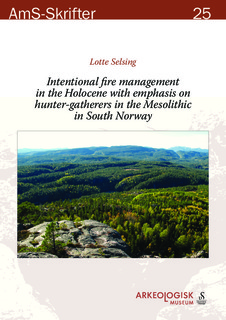| dc.description.abstract | The geographical and altitudinal distribution of the data from 68 palynological sites has allowed the synthesis of a relationship between the microscopic charcoal curves and people over time. Most of the selected sites were of archaeological interest. Quantitative methods, qualitative methods and topics about the relation between fire, charcoal, nature and people in a forested landscape were used. Palynological sites are better suited to revealing fire management activities in the Mesolithic than archaeological sites because intentional burning of vegetation was carried out in areas related to lakes and mires.
Climate is ruled out as the cause of the charcoal occurrence because there are no correlations between inferred regional climatic changes and the charcoal. This suggests that an anthropogenic explanation for the charcoal occurrence is the most plausible.
There are many indications that hunter-gatherers in the Mesolithic used fire management and that fire was an important part of cultural practice associated with settlement, population density and resource needs. Fire management was a common and regular work task integrated with other activities. The traditional lifestyle of foragers may have included customary controlled burning practices as a part of manipulating the ecological succession and the modification of vegetation communities. Burning may have been central to hunting and gathering practices and the key to many social and cultural activities. The timing of burns may have been related to weather conditions, time of year and annual cultural events.
The different pattern of temporal changes in charcoal abundance suggests that no widespread burning (i.e. on a regional or landscape-scale) had taken place. The anthropogenic burning was different from natural fires. The fires set by people were smaller and less intense. Selected areas of vegetation were burnt on a recurrent basis. They were predictable, almost immediately productive, creating mosaics in a complex pattern of vegetation of burnt and unburnt patches. Because they reduced available fuel, they provided protection against the disruptions of natural fires. The occurrence of natural fires is irregular, often with long intervals in between; they are uncontrolled, unpredictable, destructive to the vegetation and potentially dangerous for people. In order for the recorded charcoal occurrences to be considered the result of natural fires, sites close to each other should have had similar charcoal occurrences, but this is not the case. An often low and continuous charcoal presence in a more or less dense forest in the Mesolithic indicates a continuous production of charcoal, which is better interpreted as people’s use of fire than continuous natural fires.
The data confirm that anthropogenic fires were much more frequent than natural fires in the Mesolithic. Foragers did not simply adjust to their environment, but had an active, dynamic relationship with nature, using intentional burning both to modify and to maintain the environment.
Intentional burning of vegetation during the Mesolithic is suggested to have been enacted by foragers who controlled fire for many purposes and widened its application to preserve their basis of existence, for instance to improve the outcome of hunting and for communication.
Two periods with a high frequency of maximum values of charcoal in the pollen diagrams are recorded in the early (9800–6000 cal yr BP) and the late part of the Holocene (younger than 2400 cal yr BP), respectively, and not at the transition to the Neolithic. This shows that early farmers did not produce as much charcoal—measured in maxima—as the huntergatherers did before the transition to the Neolithic, and confirms foragers’ intentional burning as part of Mesolithic land-use in South Norway.
The first occurrences and high frequency of maximum values of charcoal pre-date the transition to the Neolithic and thus it can be ruled out that they were correlated with agrarian cultures in South Norway. It is possible that the selective burning carried out by foragers in vegetation paved the way for pioneer farmers to convert land for agricultural purposes. In that sense, the neolithisation was not very revolutionary, as the knowledge of using fire to manipulate and open the forest had a long pre-agrarian history.
As the path of the charcoal curve following the transition to the Neolithic is often interpreted as the result of forest clearance by farmers, a fire-related woodland change interpretation for the Mesolithic might also be used. After the transition to the Neolithic, the density of the forest in many areas decreased and allowed more charcoal deposition. The density of the forest affected the charcoal curve resulting in low values before the transition to the Neolithic compared to the values after the transition. This is a strong indication that the charcoal curve during the Mesolithic mainly originated as an effect of human activities. That the density of the forest in the Mesolithic changed more than the traditionally accepted view is probably the result of intentional fire management. | nb_NO |
